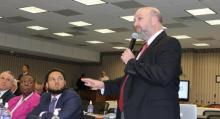Story by Debra McKinney Banks and Celeste Ryan Blyden
A longtime mainstay in many Seventh-day Adventist homes, meat analogs are steadily gaining popularity outside our community, thanks to the growing trend of plant-based eating; Meatless Monday campaigns to eliminate animal protein one day a week; the rise of flexitarians seeking to adopt a healthier lifestyle; and a segment of the population driven to alleviate chronic health issues.






